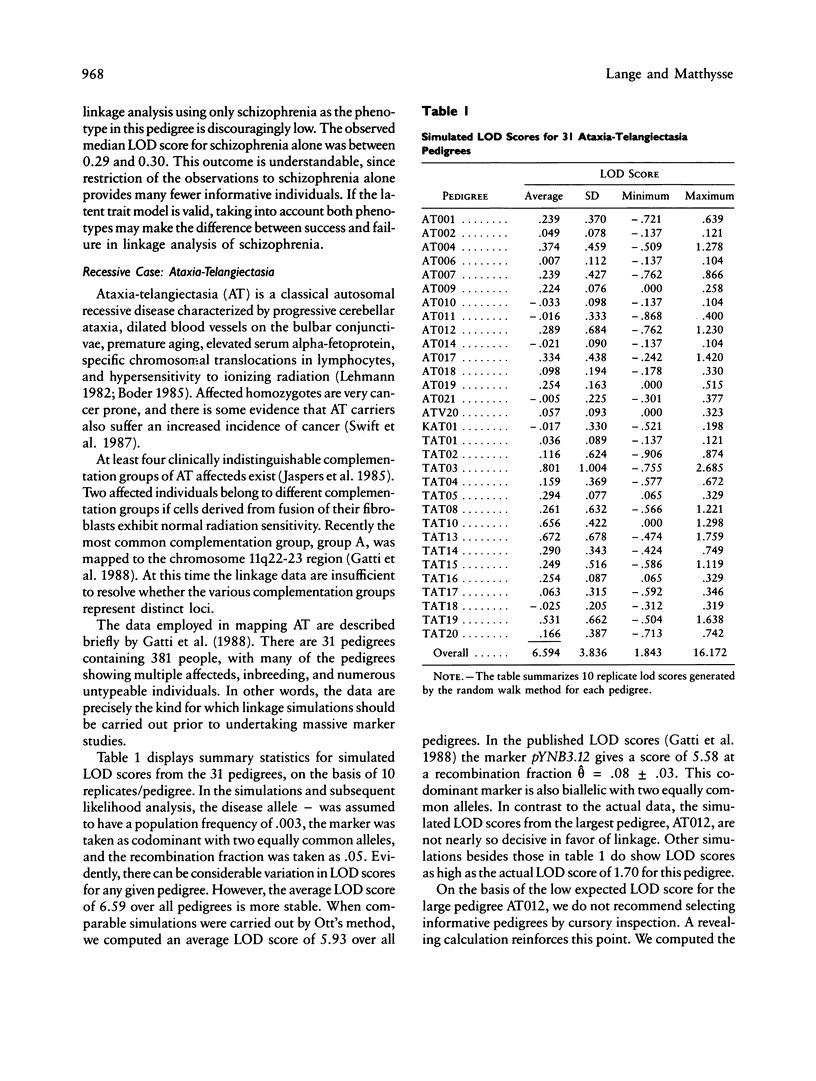Abstract
A random walk method, based on the Metropolis algorithm, is developed for simulating the distribution of trait and linkage marker genotypes in pedigrees where trait phenotypes are already known. The method complements techniques suggested by Ploughman and Boehnke and by Ott that are based on sequential sampling of genotypes within a pedigree. These methods are useful for estimating the power of linkage analysis before complete study of a pedigree is undertaken. We apply the random walk technique to a partially penetrant disease, schizophrenia, and to a recessive disease, ataxia-telangiectasia. In the first case we show that accessory phenotypes with higher penetrance than that of schizophrenia itself may be crucial for effective linkage analysis, and in the second case we show that impressionistic selection of informative pedigrees may be misleading.
Full text
PDF











Selected References
These references are in PubMed. This may not be the complete list of references from this article.
- Gatti R. A., Berkel I., Boder E., Braedt G., Charmley P., Concannon P., Ersoy F., Foroud T., Jaspers N. G., Lange K. Localization of an ataxia-telangiectasia gene to chromosome 11q22-23. Nature. 1988 Dec 8;336(6199):577–580. doi: 10.1038/336577a0. [DOI] [PubMed] [Google Scholar]
- Holzman P. S., Kringlen E., Matthysse S., Flanagan S. D., Lipton R. B., Cramer G., Levin S., Lange K., Levy D. L. A single dominant gene can account for eye tracking dysfunctions and schizophrenia in offspring of discordant twins. Arch Gen Psychiatry. 1988 Jul;45(7):641–647. doi: 10.1001/archpsyc.1988.01800310049006. [DOI] [PubMed] [Google Scholar]
- Kennedy J. L., Giuffra L. A., Moises H. W., Cavalli-Sforza L. L., Pakstis A. J., Kidd J. R., Castiglione C. M., Sjogren B., Wetterberg L., Kidd K. K. Evidence against linkage of schizophrenia to markers on chromosome 5 in a northern Swedish pedigree. Nature. 1988 Nov 10;336(6195):167–170. doi: 10.1038/336167a0. [DOI] [PubMed] [Google Scholar]
- Matthysse S., Holzman P. S., Lange K. The genetic transmission of schizophrenia: application of Mendelian latent structure analysis to eye tracking dysfunctions in schizophrenia and affective disorder. J Psychiatr Res. 1986;20(1):57–67. doi: 10.1016/0022-3956(86)90023-3. [DOI] [PubMed] [Google Scholar]
- Ott J. Computer-simulation methods in human linkage analysis. Proc Natl Acad Sci U S A. 1989 Jun;86(11):4175–4178. doi: 10.1073/pnas.86.11.4175. [DOI] [PMC free article] [PubMed] [Google Scholar]
- Ploughman L. M., Boehnke M. Estimating the power of a proposed linkage study for a complex genetic trait. Am J Hum Genet. 1989 Apr;44(4):543–551. [PMC free article] [PubMed] [Google Scholar]
- Sherrington R., Brynjolfsson J., Petursson H., Potter M., Dudleston K., Barraclough B., Wasmuth J., Dobbs M., Gurling H. Localization of a susceptibility locus for schizophrenia on chromosome 5. Nature. 1988 Nov 10;336(6195):164–167. doi: 10.1038/336164a0. [DOI] [PubMed] [Google Scholar]
- Swift M., Reitnauer P. J., Morrell D., Chase C. L. Breast and other cancers in families with ataxia-telangiectasia. N Engl J Med. 1987 May 21;316(21):1289–1294. doi: 10.1056/NEJM198705213162101. [DOI] [PubMed] [Google Scholar]
- Tsuang M. T., Winokur G., Crowe R. R. Morbidity risks of schizophrenia and affective disorders among first degree relatives of patients with schizophrenia, mania, depression and surgical conditions. Br J Psychiatry. 1980 Dec;137:497–504. doi: 10.1192/bjp.137.6.497. [DOI] [PubMed] [Google Scholar]


